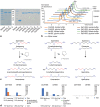The long road of functional recruitment-The evolution of a gene duplicate to pyrrolizidine alkaloid biosynthesis in the morning glories (Convolvulaceae)
- PMID: 35865076
- PMCID: PMC9295680
- DOI: 10.1002/pld3.420
The long road of functional recruitment-The evolution of a gene duplicate to pyrrolizidine alkaloid biosynthesis in the morning glories (Convolvulaceae)
Abstract
In plants, homospermidine synthase (HSS) is a pathway-specific enzyme initiating the biosynthesis of pyrrolizidine alkaloids (PAs), which function as a chemical defense against herbivores. In PA-producing Convolvulaceae ("morning glories"), HSS originated from deoxyhypusine synthase at least >50 to 75 million years ago via a gene duplication event and subsequent functional diversification. To study the recruitment of this ancient gene duplicate to PA biosynthesis, the presence of putative hss gene copies in 11 Convolvulaceae species was analyzed. Additionally, various plant parts from seven of these species were screened for the presence of PAs. Although all of these species possess a putative hss copy, PAs could only be detected in roots of Ipomoea neei (Spreng.) O'Donell and Distimake quinquefolius (L.) A.R.Simões & Staples in this study. A precursor of PAs was detected in roots of Ipomoea alba L. Thus, despite sharing high sequence identities, the presence of an hss gene copy does not correlate with PA accumulation in particular species of Convolvulaceae. In vitro activity assays of the encoded enzymes revealed a broad spectrum of enzyme activity, further emphasizing a functional diversity of the hss gene copies. A recently identified HSS specific amino acid motif seems to be important for the loss of the ancestral protein function-the activation of the eukaryotic initiation factor 5A (eIF5A). Thus, the motif might be indicative for a change of function but allows not to predict the new function. This emphasizes the challenges in annotating functions for duplicates, even for duplicates from closely related species.
Keywords: Distimake; Ipomoea; deoxyhypusine synthase; gene duplication; homospermidine synthase; molecular evolution; pyrrolizidine alkaloids.
© 2022 The Authors. Plant Direct published by American Society of Plant Biologists and the Society for Experimental Biology and John Wiley & Sons Ltd.
Conflict of interest statement
The authors declare that they have no competing interests.
Figures




Similar articles
-
Homospermidine synthase evolution and the origin(s) of pyrrolizidine alkaloids in Apocynaceae.Am J Bot. 2025 Feb;112(2):e16458. doi: 10.1002/ajb2.16458. Epub 2025 Jan 30. Am J Bot. 2025. PMID: 39887714 Free PMC article.
-
Evolution of homospermidine synthase in the convolvulaceae: a story of gene duplication, gene loss, and periods of various selection pressures.Plant Cell. 2013 Apr;25(4):1213-27. doi: 10.1105/tpc.113.109744. Epub 2013 Apr 9. Plant Cell. 2013. PMID: 23572540 Free PMC article.
-
Evolution of pyrrolizidine alkaloids in Phalaenopsis orchids and other monocotyledons: identification of deoxyhypusine synthase, homospermidine synthase and related pseudogenes.Phytochemistry. 2009 Mar;70(4):508-16. doi: 10.1016/j.phytochem.2009.01.019. Epub 2009 Feb 28. Phytochemistry. 2009. PMID: 19254800
-
Phylogenetic origin of a secondary pathway: the case of pyrrolizidine alkaloids.Plant Mol Biol. 2000 Nov;44(4):445-50. doi: 10.1023/a:1026597621646. Plant Mol Biol. 2000. PMID: 11197320 Review.
-
Pyrrolizidine alkaloid biosynthesis, evolution of a pathway in plant secondary metabolism.Phytochemistry. 2009 Oct-Nov;70(15-16):1687-95. doi: 10.1016/j.phytochem.2009.05.017. Epub 2009 Jun 21. Phytochemistry. 2009. PMID: 19545881 Review.
Cited by
-
Mutational biases favor complexity increases in protein interaction networks after gene duplication.Mol Syst Biol. 2024 May;20(5):549-572. doi: 10.1038/s44320-024-00030-z. Epub 2024 Mar 18. Mol Syst Biol. 2024. PMID: 38499674 Free PMC article.
-
The Antioxidant and Anti-Inflammatory Properties of Merremia umbellata Extract.Antioxidants (Basel). 2023 Nov 23;12(12):2037. doi: 10.3390/antiox12122037. Antioxidants (Basel). 2023. PMID: 38136157 Free PMC article.
-
Homospermidine synthase evolution and the origin(s) of pyrrolizidine alkaloids in Apocynaceae.Am J Bot. 2025 Feb;112(2):e16458. doi: 10.1002/ajb2.16458. Epub 2025 Jan 30. Am J Bot. 2025. PMID: 39887714 Free PMC article.
References
-
- Austin, D. F. (1979). An infrageneric classification for Ipomoea (Convolvulaceae). Taxon, 28(4), 359–361.
LinkOut - more resources
Full Text Sources
Miscellaneous

